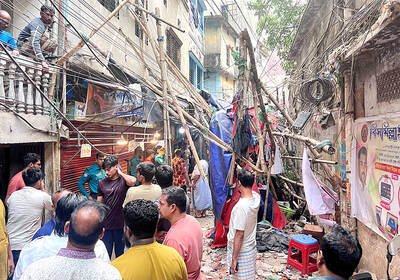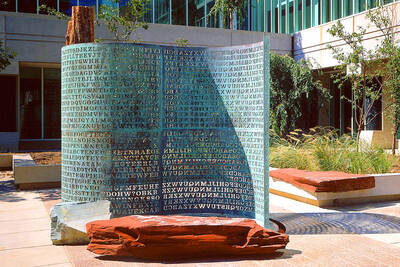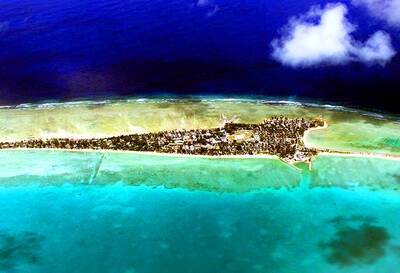A frostbitten Italian climber limped into K2 base camp yesterday after an ice fall that killed 11 others, but swirling cloud prevented helicopters from plucking him from the world’s second-highest peak.
Marco Confortola, believed to be the only survivor of Friday’s catastrophic avalanche, finally hobbled into the 5,200m camp with his toes blackened by exposure to sub-zero temperatures, officials said.
Shaukat Zaman, a tourism ministry official, said the other 11 climbers were all presumed dead.
“Only some miracle can save any of them,” he said.
Confortola reached the summit on Friday before the avalanche struck.
“The danger is over,” said Ashraf Aman, head of mountaineering company Adventure Tours Pakistan, which has played a key role in rescue operations.
“Marco has reached the main base camp, he is recovering. The base camp has facilities to provide him with immediate medical help like oxygen and drugs, so he will improve gradually,” Aman told reporters.
An Italy-based member of Confortola’s climbing team, Agostino Da Polenza, told Sky TG24 television that the mountaineer had reached base camp and was awaiting evacuation by helicopter.
Slowed by his frostbitten feet, the 37-year-old Confortola had spent four nights trying to reach base camp and was helped down by Pakistani high-altitude porters who managed to get to him on Monday.
But rescuers said they feared the choppers would not be able to take off at all yesterday because of storms and thick cloud around the mountain, which climbers regard as tougher and more dangerous to scale than Everest. K2 is steeper, rockier and more prone to sudden, severe weather.
“I don’t think a rescue mission would be possible today,” said Colonel Ilyas Mirza, a senior official of Askari Aviation, an army-linked company based in the northern town of Skardu that operates the rescue choppers.
“The weather is still bad, flying in Skardu and beyond was not possible this morning,” Mirza said.
But he said that the helicopters, specially equipped for high-altitude missions, remained on standby.
“Our helicopters are ready, waiting for an improvement in the situation. They may try to make an attempt this evening if the weather improves even for a few hours,” he said.
Army helicopters on Monday rescued two Dutch mountaineers from K2. They tried to reach the Italian on Monday as well, but were prevented by storms.
Three South Koreans, two Nepalis, two Pakistanis, a Serbian, an Irishman, a Norwegian and a Frenchman died in Friday’s avalanche, the worst disaster ever to happen on the mountain.
A pillar of ice broke away in a steep gully known as the Bottleneck near the summit and swept away fixed lines used by the mountaineers as they made their descent.
One of the Dutchmen, Wilco Van Rooijen, blamed mistakes in preparation for the final ascent — not just the avalanche — for one of mountaineering’s worst disasters.
“Everything was going well to Camp Four, and on summit attempt everything went wrong,” Van Rooijen told reporters by phone on Monday from a military hospital where he was being treated for frostbitten toes.
Van Rooijen said advance climbers laid ropes in some of the wrong places, including in a treacherous gully known as “The Bottleneck,” about 350m below the summit.
That caused hours of delays, so climbers only reached the summit just before nightfall. As the fastest mountaineers descended, a huge serac, or column of ice, fell. The ice swept away some of the ropes, making it even more dangerous for those caught above.

DISASTER: The Bangladesh Meteorological Department recorded a magnitude 5.7 and tremors reached as far as Kolkata, India, more than 300km away from the epicenter A powerful earthquake struck Bangladesh yesterday outside the crowded capital, Dhaka, killing at least five people and injuring about a hundred, the government said. The magnitude 5.5 quake struck at 10:38am near Narsingdi, Bangladesh, about 33km from Dhaka, the US Geological Survey (USGS) said. The earthquake sparked fear and chaos with many in the Muslim-majority nation of 170 million people at home on their day off. AFP reporters in Dhaka said they saw people weeping in the streets while others appeared shocked. Bangladesh Interim Leader Muhammad Yunus expressed his “deep shock and sorrow over the news of casualties in various districts.” At least five people,

ON THE LAM: The Brazilian Supreme Court said that the former president tried to burn his ankle monitor off as part of an attempt to orchestrate his escape from Brazil Former Brazilian president Jair Bolsonaro — under house arrest while he appeals a conviction for a foiled coup attempt — was taken into custody on Saturday after the Brazilian Supreme Court deemed him a high flight risk. The court said the far-right firebrand — who was sentenced to 27 years in prison over a scheme to stop Brazilian President Luiz Inacio Lula da Silva from taking office after the 2022 elections — had attempted to disable his ankle monitor to flee. Supreme Court judge Alexandre de Moraes said Bolsonaro’s detention was a preventive measure as final appeals play out. In a video made

It is one of the world’s most famous unsolved codes whose answer could sell for a fortune — but two US friends say they have already found the secret hidden by Kryptos. The S-shaped copper sculpture has baffled cryptography enthusiasts since its 1990 installation on the grounds of the CIA headquarters in Virginia, with three of its four messages deciphered so far. Yet K4, the final passage, has kept codebreakers scratching their heads. Sculptor Jim Sanborn, 80, has been so overwhelmed by guesses that he started charging US$50 for each response. Sanborn in August announced he would auction the 97-character solution to K4

SHOW OF FORCE: The US has held nine multilateral drills near Guam in the past four months, which Australia said was important to deter coercion in the region Five Chinese research vessels, including ships used for space and missile tracking and underwater mapping, were active in the northwest Pacific last month, as the US stepped up military exercises, data compiled by a Guam-based group shows. Rapid militarization in the northern Pacific gets insufficient attention, the Pacific Center for Island Security said, adding that it makes island populations a potential target in any great-power conflict. “If you look at the number of US and bilateral and multilateral exercises, there is a lot of activity,” Leland Bettis, the director of the group that seeks to flag regional security risks, said in an